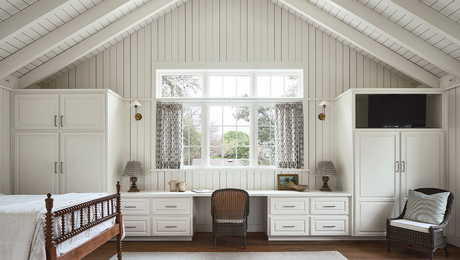I am in the process of installing cherry stairs in our new home and want to know what I should do to prevent future squeaks. I have built the treads myself with 7/8″ wood and bisquited the alternating 2 1/2″ – 3″ strips. Should I use the red underlayment paper, building paper, or what? Should the screws be a certain distance apart? Any advice will be appreciated. Thanks.
Discussion Forum
Discussion Forum
Up Next
Video Shorts
Featured Story

This 654-sq.-ft. ADU combines vaulted ceilings, reclaimed materials, and efficient design, offering a flexible guest suite and home office above a new garage.
Featured Video
Builder’s Advocate: An Interview With ViewrailHighlights
"I have learned so much thanks to the searchable articles on the FHB website. I can confidently say that I expect to be a life-long subscriber." - M.K.
Fine Homebuilding Magazine
- Home Group
- Antique Trader
- Arts & Crafts Homes
- Bank Note Reporter
- Cabin Life
- Cuisine at Home
- Fine Gardening
- Fine Woodworking
- Green Building Advisor
- Garden Gate
- Horticulture
- Keep Craft Alive
- Log Home Living
- Military Trader/Vehicles
- Numismatic News
- Numismaster
- Old Cars Weekly
- Old House Journal
- Period Homes
- Popular Woodworking
- Script
- ShopNotes
- Sports Collectors Digest
- Threads
- Timber Home Living
- Traditional Building
- Woodsmith
- World Coin News
- Writer's Digest


















Replies
Glue (pl premium) and screw the treads to the stringers (pocket screws if you don't want surface plugs and screw from the backside of the riser into the tread.
A Great Place for Information, Comraderie, and a Sucker Punch.
Remodeling Contractor just outside the Glass City.
http://www.quittintime.com/
The biggest offender for me when installing treads is squeaks at the front of the tread where the portion of the tread overhangs the riser and moves against the skirt. If the treads are too tight, they squeak, and too loose and a gap is visible. I suggest a stair jig, they pay for themselves pretty quick
I made a stair jig anticipating trouble with fitting the treads against the skirtboards. To avoid squeaks how much of a gap do you recommend between the treads and the skirtboard?
Less than a playing card, or lightly touching. In my experience it's the too snug ones that squeak or pop. I also have a pull saw that I have filled the rake of one side so I can put it up against the skirt and cut the tread a bit, if a squeak shows itself after the treads is all glued down. Are the skirts to be painted? If so, you have a tiny bit more latitude there.
No paint. They will be finished with Siikens floor finish,
Treads are housed/wedged into skirts, or butted into skirts? (I assumed butted with my advice.) Also, if the treads are 1" that should also help with any movement at the nosing.
Housed or cut stringers?
Welcome to the
Taunton University of Knowledge FHB Campus at Breaktime.
where ...
Excellence is its own reward!
Housed. 5 to a landing and then 7 to the top.
OK, I work with cut stringers, glue and screws. I don't have experience with housed.
Welcome to the Taunton University of Knowledge FHB Campus at Breaktime. where ... Excellence is its own reward!
How do you hide the screws, bungs?
With either cut stringers, or housed, you can use pocket screws from underneath/ behind.
all screws hidden; no bungs needed.
if you have access. I've got a stair coming up on a house I'm building, and am thinking of having the plasters leave the well to the basement undone, just so I can hide all fasteners. Kind of turns trimming the stairs into a 2 man job though. (The stair have a plywood permanent sub riser and tread already on for rough in)
With a permanent plywood rise and tread already in place, I'd be tempted to tack the finish rise and tread on with a few brads from a nail gun, using generous amounts of construction adhesive, then screwing everything from behind.
The most important thing you can do is use plenty of good construction adhesive. I've done them with screws & bungs, finish nails, hardwood flooring,etc. and nothing beats good adhesive on clean carriages. If you are going to do a full housed and wedged stair I'm currently doing one which is housed on the wall side and mitered on the open side and could provide some pics which could help.